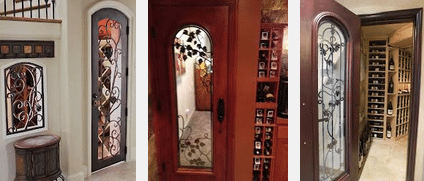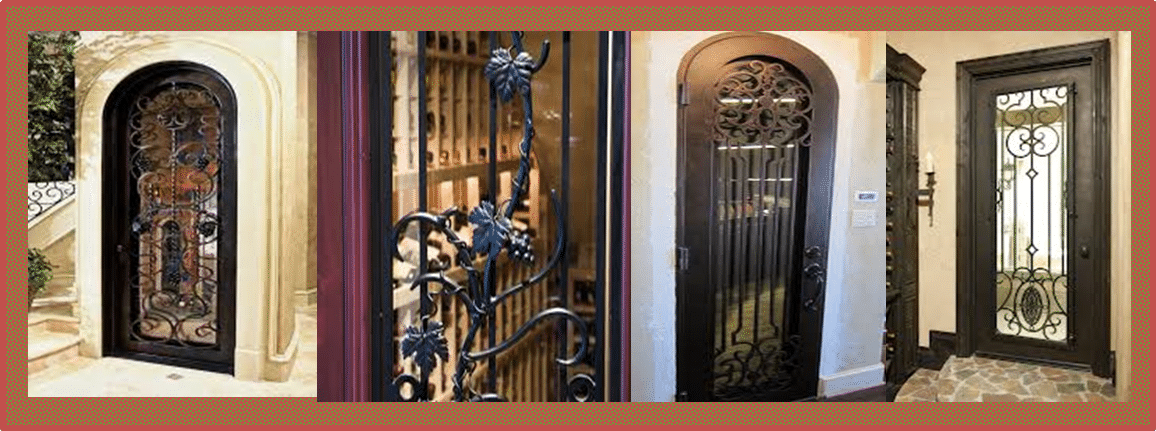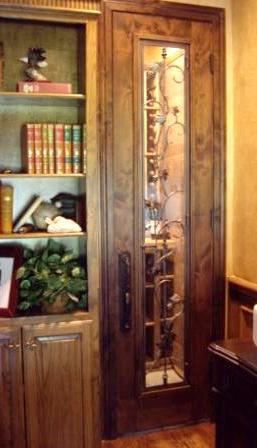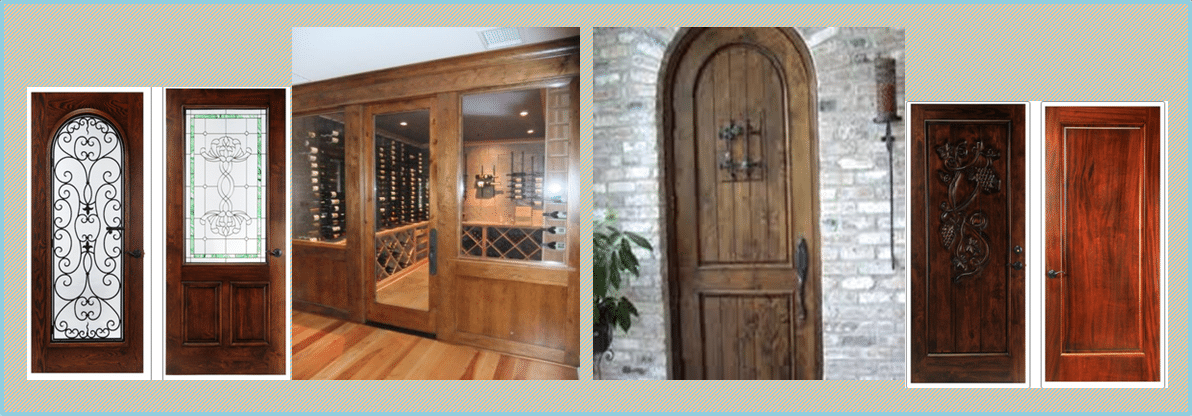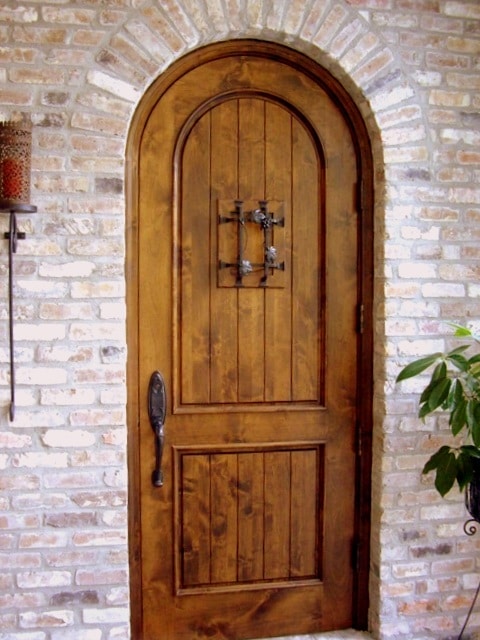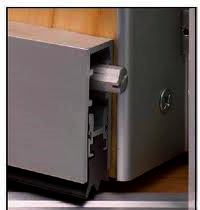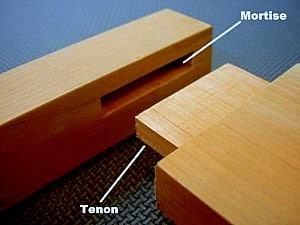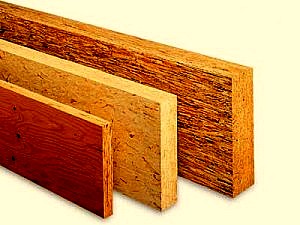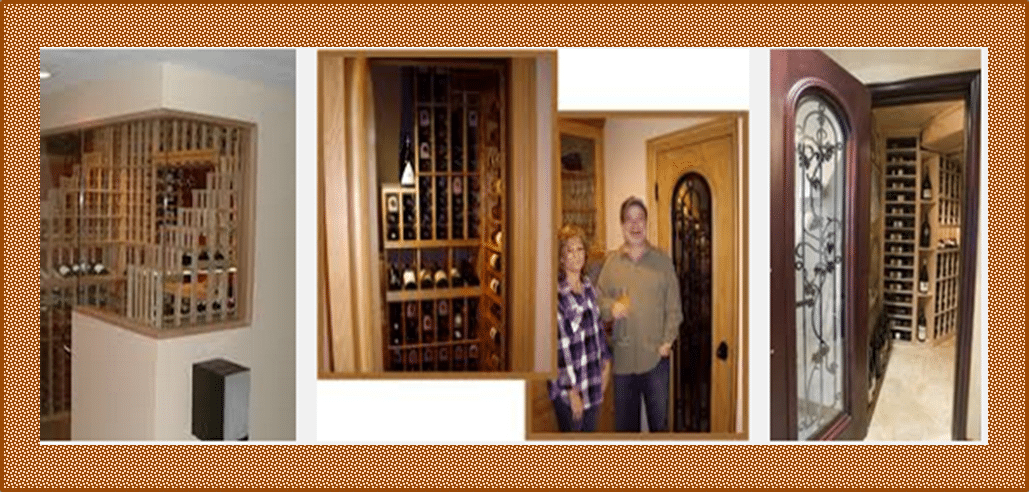Custom Wine Cellar Doors – A Critical Component in Building a Wine Cellar
The entry door to a wine storage room is an often underrated part of building a wine cellar, but it is nevertheless one of the most critical components of a climate-controlled wine cellar space.
Wine cellar doors in Chicago are purpose-built to completely seal a custom wine room, and thereby protect its environment from outside elements.
Entryway doors to a wine cellar are specially made to withstand warping and twisting. Additionally, custom wine cellar doors are designed to match the style and quality of the wine storage space.
The two basic types of wine cellar entryways are wrought iron and wood-based entry doors. Each has its own unique features that provide a nice seal, as well as add elegance to the appearance of the wine room.
Wrought Iron Wine Cellar Doors
Hand forged wrought iron wine cellar doors are custom manufactured to meet the design specifications of each client. Wrought iron entryway doors are hot forged by skilled and experienced craftsmen.
Custom wine cellar doors in wrought iron have intricate patterns and detailed designs that add character and lend a unique look to the wine storage room.
Wrought iron wine cellar doors are made from a combination of 16 and 18-gauge steel, which indicates the thickness of the wrought iron.
To keep the door weather tight, foam and rubber weather stripping are applied around the door frame, glass frame, and rubber sweep. In addition, polyurethane foam is injected into the frame and body to keep the wine cellar door well-insulated.
Entryway doors in hand forged wrought iron use dual pane tempered glass for added insulation. The interior glass panels are operable, meaning they can be opened and closed to allow for ease of cleaning. To improve door weatherization and prevent oxidation, layers of acrylic primer and sealant are applied to wine cellar entryway doors.
Wood-Based Custom Wine Cellar Entryways
Handcrafted wood-based wine cellar doors by Custom Wine Cellars Chicago are LVL engineered with mortise and tenon corners. LVL timber (or laminated veneer lumber) is a wood product that consists of multiple layers of thin wood veneers, assembled in uniform patterns and bonded together by adhesives. Custom wine cellar doors made from LVL timber are less likely to shrink, warp or twist, due to LVL’s composite quality.
Mortise and tenon corners add strength and structural integrity to wine cellar entryway doors. This woodworking joint is one of the oldest construction techniques and is considered to be among the strongest framing joints.
Wood wine cellar doors come with an automatic door bottom, which seals the opening at the bottom and prevents outside elements from filtering through the wine storage room. An automatic door bottom is a device that consists of a horizontal bar, which is fitted along the door bottom. The bar automatically retracts upward when the door is opened and drops down when the door is closed.
Various hand-carved wood designs are available to give wine cellar entryway doors a custom look. Different stains and lacquer color options are offered to match a range of custom wine cellar designs and styles. Only the best wood species (e.g. Knotty Alder, Clear Alder, and African Mahogany) are used in the construction of wood wine cellar doors.
Important Parts of a Wine Cellar Door
Aside from knowing the two types of wine cellar doors, it is also necessary to know and understand what features to look for in order to pick a quality wine cellar door.
Automatic Door Bottom
First is the automatic door bottom. This is the part of custom wine cellar doors that keeps a tight seal and prevents cooled air from escaping the wine room. Automatic door bottoms prevent damage to the flooring by inhibiting door dragging.
Mortise and Tenon
Second is the mortise and tenon, a technology utilized by woodworkers to give doors an extra support structure. This is actually a joint that connects wood pieces; a hole (mortise) is bored into a wood piece, and then a tenon cut to fit the hole is inserted into the mortise, to make a solid joint.
Laminated Veneer Lumber (LVL)
Third is laminated veneer lumber or LVL, a new technology that only a few manufacturers offer. This comprises multiple layers of thin-cut wood that are joined together by strong wood adhesives. Found at the core of wine cellar doors, the laminated veneer lumber is known to be highly resistant to shrinking and warping and has very good insulating characteristics.
The other parts of a wine cellar door include a T-astragal, which secures the inactive side of the door unit; foam and rubber, surrounding the door frame for weather stripping; a rubber sweep; ball bearing hinges that are heavy-duty; and dual-paned tempered glass, for glass wine cellar doors.
Product specifications, such as the wood type, wood stain, color, security features, acrylic primer, faux finish, and sealant, are also considered. These will also define the quality and longevity of your wine cellar door.
Other Essentials in Building a Wine Cellar
A wine cellar door is a crucial element of wine cellar design and construction. When building a wine cellar, it is important to install an entryway door that will not only help maintain the ideal storage environment but also enhance the beauty of the wine storage room.
A good wine cellar designer or custom wine cellar door manufacturer should be able to offer a CAD drawing of the wine cellar door, along with complete design specifications. In most cases, you can ask for a drawing to see what the door will look like. The installation must be done by a licensed and experienced installer.
The process of building a wine cellar involves the proper installation of insulation, vapor barriers, and a refrigeration system, as well as picking out an elegant wine cellar door that will seal the room and serve as an excellent focal point for a wine cellar space.
Custom Wine Cellars Chicago is partnered with Wine Cellar Specialists. This expert wine cellar builder offers quality custom wine cellar doors in Chicago.







